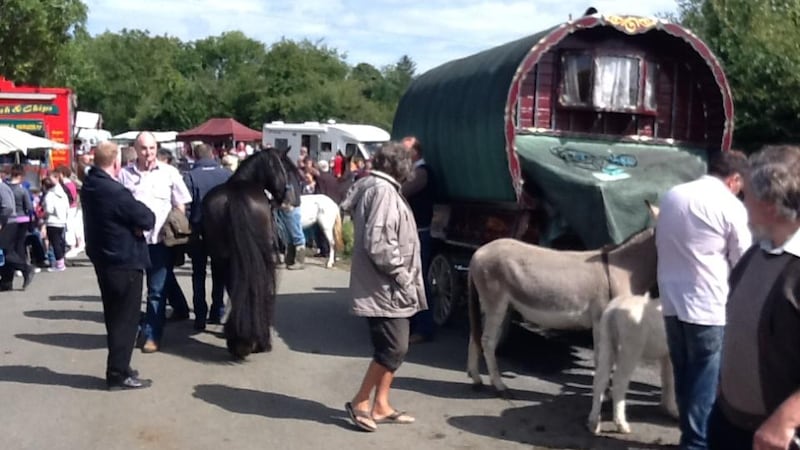There are no roadsigns pointing to Muff. Or at least none that I could see on Monday, as I explored the boreens of east Cavan looking for the famous fair. I imagine it would be hard to keep such signs in place anyway. They might have a habit of migrating to Irish pubs in London and New York, for the amusement of the immature.
But then again, in their original location, the signs would not have much at which to point on 364 days of every year. Muff is not a village. It’s not even a crossroads. In fact, you’d struggle to find a location less suitable for an annual influx of jeeps and horse-boxes. Which said, it was the build-up of traffic in an otherwise intensely bucolic area that helped me find the place eventually. When I had to reverse 50 metres along a winding L-route to let a Hiace van pass in the opposite direction, I knew I was close.
There used to be a castle in Muff, built by the O’Reilly clan. But it appears to have succumbed to Cromwell, and was already a distant memory when a 19th- century travel writer, Rev Randall McCullum, visited the area.


In his 1856 book, The Highlands of Cavan, McCullum records that, even then, the place comprised just "a few cabins", adding that the area's only slated house had been destroyed during a faction fight in the early 1830s.
“These faction fights at fairs and markets are now going out of fashion,” wrote the relieved reverend. “They were once quite common in County Cavan and seem to have been the last remnant of a barbarous age.”
Cabins apart, the area also had (and retains) a natural landmark – Muff Rock – which is presumed central to its ancient role. The fair dates from at least 1608, when King James granted a licence. But that probably marked nothing more that the event’s entry into written history.
Scholars believe it to be much older than that. Indeed, like other August 1st festivals (it was moved to August 12th after the 1752 calendar change), it may even go back to pre-Christian times and celebrations of the god Lugh.
There is no reference to Lugh at the modern version, except perhaps phonetically (via the Portaloos). And yet those same Portaloos, and the vehicles most people now arrive in, are about the only concessions to progress. Above all, the fair remains remarkably uncommercialised, beyond the basic transactions that are still at its heart.
Horses – piebalds, mostly – are the chief attraction, followed by donkeys. There were a few goats too on Monday, and hens, as well as a man selling greyhound pups. There were also numerous stalls, offering everything from equestrian hardware to lowest-grade tat.
But apart from a chip van, and a fortune-telling “seventh daughter of a seventh daughter”, the service industries have not yet cashed in.
There are no pubs in the area either: the nearest town is Kingscourt, several miles away. So serious socialising is confined to a tin-roofed shed, with tea and sandwiches, a makeshift bar, and a dancefloor for waltzes, jives,
or the occasional Siege of Ennis.
And yet most of the fair seemed to be about socialising. With the exception of a fast-talking hen-seller (“Them ones are six euro apiece, and they’re the best value here – I won’t tell you a lie. You needn’t be coming back later looking to get them cheap! When you have good stock, they sell themselves”), business was very low-key. Most people just seemed to be milling about, renewing annual acquaintances.
Violence doesn’t seem to be a feature any more, either. The nearest thing I saw to a fracas was when a tethered mare and her foal became accidentally entangled. The foal had somehow wrapped the rope around his neck, turning it into a noose. Then he panicked, slipped, and nearly hanged himself, which panicked the mother too.
“Cut the rope!” I and another onlooker suggested simultaneously. A third man thought it was too late: “He’s dead.” Happily he wasn’t. While the owner fumbled for a penknife, the foal worked out that not moving would be a good idea. Somebody else was able to untie the rope and the foal was freed.
The event has a Facebook page these days, and a website is promised. I shudder to think what sort of traffic a fairofmuff.com might attract on Google searches (especially if it also mentions that there’s a town called “Nobber” out the road).
For the moment, however, the fair seems untouched by the modern world. When I left, the band was playing a country-and-western number. But regardless of the music, or the steps, the people were still dancing at Lughnasa.
fmcnally@irishtimes.com









